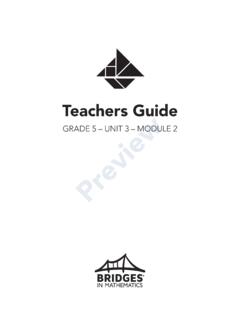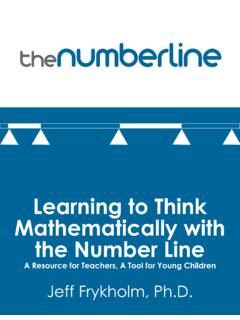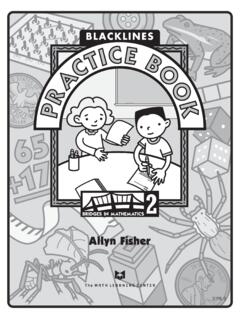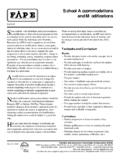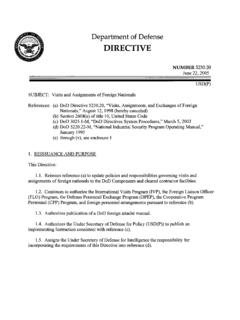Transcription of Bridges in Mathematics Grade 5 Unit 1 Module 1
1 Teachers GuideGRADE 5 UNIT 1 Module 1 PreviewPreviewSession 1 Building a Community 3 Session 2 More About The Product Game 9 Session 3 Unit 1 Pre-Assessment 15 Session 4 Boxing Baseballs 19 Session 5 More Baseball Boxes 27 Module 1 Multiplication & VolumeTeacher MastersPages renumber with each Place Guide 1A The Product Game T11A The Product Game Record Sheet T2 Math Topics T3 Unit 1 Pre-Assessment T4 Base Ten Grid Paper T7 Mathography T8 Boxing Baseballs T10 More About Brad's Baseballs T 11 Unit 1 Pre-Assessment Student Reflection Sheet
2 T12 Two-Centimeter Grid Paper T13 Student Book PagesPage numbers correspond to those in the consumable Place Instructions 1A The Product Game 1 You Choose 2 Product Game Problems 3 More Product Game Problems 4 Facts & Boxes 5 Fact Connections 6 Home Connections PagesPage numbers correspond to those in the consumable s the Problem? 1 Multiplication Connections 3 The Math Learning Center | in Mathematics Grade 4 Teachers GuidePreviewPreview The Math Learning Center | in Mathematics Grade 5 Teachers Guide1 Unit 1 Module 1 Multiplication & VolumeOverviewModule 1 sets the tone for the year and establishes what a math community looks and sounds like.
3 After playing Work Place 1A The Product Game several times, students discuss strategies and use the game board to make mathematical observations and preview math strands they will encounter during the course of the year. In Session 3, students take the Unit 1 Pre-Assessment and complete Mathographies, reflective writing that gives a glimpse into their understanding and beliefs about mathemat-ics. The first investigation of the year invites them to work with properties of multiplication and volume. In the final session, students reflect on the Unit 1 Pre-Assessment and are introduced to the first problem string of the & Work Places IntroducedP&IPSMFWPAHCDPS ession 1 Building a CommunityStudents discuss what a Mathematics community looks and sounds like The teacher records responses and emphasizes the need for a respectful.
4 Focused environment Students are introduced to their first Work Place Work Place 1A The Product GamePlayers try to claim four spaces in a row by finding products of given factors On each turn a player can change one of two factors to try to make the best possible move Session 2 More About The Product GameStudents play The Product Game and then discuss game strategies and evaluate their work on building a community of learners Then they examine The Product Game Record Sheet, record mathematical observations, and sort their observations by math topic Session 3 Unit 1 Pre-AssessmentStudents take the Unit 1 Pre-Assessment Then, they fill out individual mathographies that the teacher collects and stores for the rest of the year Session 4 Boxing BaseballsStudents learn about a business owner who needs to decide how he will box 24 baseballs to ship to customers Students work in partners to find all of the possible solutions Then the class reconvenes to share a few of their strategies Session 5 More Boxing BaseballsStudents review their work on the Unit 1 Pre-Assessment and complete a self-reflection sheet The teacher leads the first problem string of the year, and students continue to work on the baseball boxing problem for the rest of the session P&I Problems & Investigations, PS Problem String, MF Math Forum, WP Work Place, A Assessment, DP Daily Practice.
5 HC Home ConnectionUnit 1 Module 1 Preview The Math Learning Center | in Mathematics Grade 5 Teachers Guide2 Unit 1 Module 1 IntroductionMaterials PreparationEach session includes a complete list of the materials you ll need to conduct the session, as well as notes about any preparation you ll need to do in advance. If you would like to prepare materi-als ahead of time for the entire Module , you can use this to-do s kDoneCopiesRun copies of Teacher Masters T1 T13 according to the instructions at the top of each master If students do not have their own Student Books, run a class set of Student Book pages 1 6 If students do not have their own Home Connections books, run a class set of the assignments for this Module using Home Connections pages 1 4 Work Place PreparationPrepare the materials for Work Place 1A using the lists of materials on the Work Place Guides (Teacher Master T1) ChartsMake a T-chart and label one column Looks Like and the other column Sounds Like for Session 1 Paper CuttingCut two of each the following arrays out of 1-inch grid paper.
6 4 3, 4 6, 8 6, 4 12, 2 24, 1 48, 3 16 for Session 5 You will label these with student help during the lesson You will need 8 10 sheets of grid paper Special ItemsWrite student names on Student Books and have them ready to pass out in Session 1 Write student names on spiral or composition notebooks to use as math journals and have them ready to pass out in Session 2 Additional ResourcesPlease see this Module s Resources section of the Bridges Educator site for a collection of resources you can use with students to supplement your instruction Preview The Math Learning Center | in Mathematics Grade 5 Teachers Guide3 Unit 1 Module 1 Session 1 Building a Community SummaryIn this session, students discuss what a Mathematics community looks like and sounds like The teacher records responses on a chart and emphasizes the need for a respectful, focused environment in which all students feel comfortable and are able to learn Then, students are introduced to their first Work Place, The Product Game Skills & Concepts Find all factor pairs for a whole number between 1 and 100 (4 OA 4) Demonstrate an understanding that a whole number is a multiple of each of its factors (4 OA 4) Determine whether a whole number between 1 and 100 is a multiple of a given 1-digit number (4 OA 4) Reason abstractly and quantitatively (5 MP 2) Construct viable arguments and critique the reasoning of others (5 MP 3)
7 MaterialsCopiesKit MaterialsClassroom MaterialsProblems & Investigations Building a Community chart paper markersWork Places Introducing Work Place 1A The Product GameTM T1 Work Place Guide 1A The Product GameTM T2 1A The Product Game Record SheetSB 1* Work Place Instructions 1A The Product Game 2 game markers, each a different colorDaily Practice SB 2 You ChooseHC Home Connection, SB Student Book, TM Teacher Master Copy instructions are located at the top of each teacher master.* Run 1 copy of this page for use by the teacher and other adult helpers during Work Place Prepare Student Books for use by writing students names on them Make a T-chart on a sheet of chart paper Label one column Looks Like and the other column Sounds Like In today s session, you ll introduce Work Place 1A The Product Game Before this session, you should review the Work Place Guide and Work Place Instructions Make copies of 1A The Product Game Record Sheet.
8 You ll need a single copy for use today, 1 copy per stu-dent pair for class use in Session 2, and a class set plus extra to store in the Work Place 1A The Product Game tray, along with the materials listed on the guide The Work Place Guide also includes suggestions for differentiating the game to meet students needs Vocabulary An asterisk [*] identifies those terms for which Word Resource Cards are *factor*multiple*multiply*product* Implementing Work PlacesFor additional information about setting up Work Places and managing them effectively, see the Implementation section of the Bridges Educator site Unit 1 Module 1 Session 1 Preview The Math Learning Center | in Mathematics Grade 5 Teachers Guide4 Unit 1 Module 1 Session 1 Problems & InvestigationsBuilding a Community1 Gather students in the discussion area.
9 Set the stage for today s session with a discussion about what makes a community of learners. Start by talking about the role students will play as mathematicians this year. Then ask them what they think math class should look like and sound like so everyone has a chance to think, ask questions, and learn. Te a c h e r We are going to do a lot of important work in math this year, and you are all going to help because all of you are mathematicians. A mathematician is someone who thinks about math, talks about math, asks math questions, and solves math problems. Mathematicians often try to find the most efficient way to solve a problem. A mathematician is also someone who makes mistakes and then tries to figure out how to fix them, even if that takes some time. Mathematicians sometimes work together and sometimes they work alone.
10 Sometimes they help someone else learn something, and sometimes someone else helps them. Right now, I want you to start thinking about some of the things that will help you be a mathematician this year. What should our room sound like and what should it look like while we are doing math?2 Give students a minute or two of quiet think time to consider your ques-tions, and then invite students to share their ideas one at a time. Record students suggestions on the prepared To help students understand what you are saying, use gestures, write key words where everyone can see, and if necessary and possible, invite bilingual students to help translate. Your goal is to help all students become better mathematicians, which is more likely to happen if students feel safe, comfortable, and respected. Encourage students to clarify their ideas and be descriptive about what the room will look and sound like.

